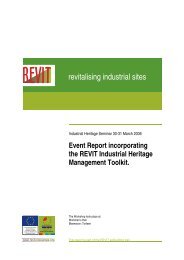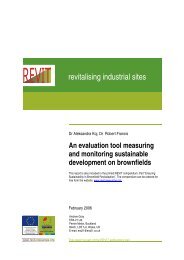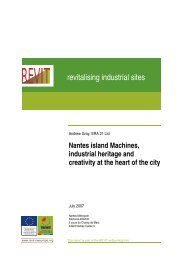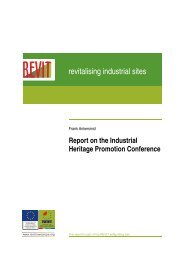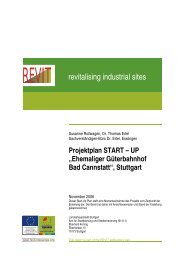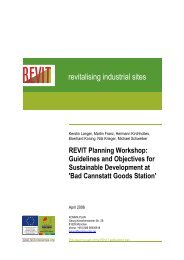REVIT Heritage Report.pdf
REVIT Heritage Report.pdf
REVIT Heritage Report.pdf
Create successful ePaper yourself
Turn your PDF publications into a flip-book with our unique Google optimized e-Paper software.
Torfaen County Borough Council<br />
<strong>REVIT</strong>: A Review of the Conservation of Industrial <strong>Heritage</strong> Assets on Brownfield Sites<br />
3 Industrial <strong>Heritage</strong>: Legal and Policy Background<br />
3.1 International Overview<br />
3.1.1 In 1972 the United Nations Educational, Scientific and Cultural Organization<br />
(UNESCO) produced the Convention Concerning the Protection of the World<br />
Cultural and Natural <strong>Heritage</strong> which sought to protect the cultural heritage in<br />
signatory areas.<br />
3.1.2 UNESCO produces the list of World <strong>Heritage</strong> Sites (WHS), under the advice of<br />
the International Council on Monuments and Sites (ICOMOS), which seeks to<br />
protect sites of international importance.<br />
3.1.3 The standards of the Council of Europe are indicated in a series of Convention<br />
for the safeguarding:<br />
• architectural heritage (Grenada, October 3, 1985),<br />
• convention on the protection of the archaeological inheritance (Valetta,<br />
January 16, 1992)<br />
• landscape (Florence, October 20, 2000). European Convention Generally<br />
the recommendations of the Council of Europe in the field of the heritage<br />
are taken into account in the national legislation.<br />
3.2 England<br />
<strong>Heritage</strong> Bodies<br />
3.2.1 In England the Department of Culture, Media and Sport (DCMS) is the central<br />
UK Government Department responsible for Government policy on the arts,<br />
sport and recreation, the National Lottery, libraries, museums and galleries,<br />
export licensing of cultural goods, broadcasting, film, press freedom and<br />
regulation, the built heritage, the royal estate and tourism.<br />
3.2.2 In England various government supported bodies protect and manage the<br />
archaeological and built heritage. These organizations recommend to the<br />
relevant minister buildings for listing and monuments for scheduling and parks<br />
and gardens for registering as well as retaining the definitive base data on<br />
such protected sites.<br />
3.2.3 In England the executive organization responsible for the protection of<br />
archaeological sites, monuments, listed buildings and parks and gardens is<br />
English <strong>Heritage</strong> (EH). Some movement towards centralisation of heritage<br />
functions has taken place in England, as the Royal Commission on Historical<br />
Monuments of England, which maintains its own National Monument Records,<br />
has been absorbed into EH.<br />
3.2.4 At a local level, in England local planning authorities usually retain their own<br />
archaeological staff who advise on the archaeological impact of planning<br />
applications. In England these archaeological groups maintain databases of<br />
their areas called the Sites and Monuments Record (SMR), increasingly known<br />
as Historic Environment Records (HER).<br />
3.2.5 In England the various local authorities also generally retain their own<br />
architectural conservation staff, although some rely on consultants or adjacent<br />
local authority staff to fill this function. The conservation staff provides advice<br />
0014021/JM/001 5




